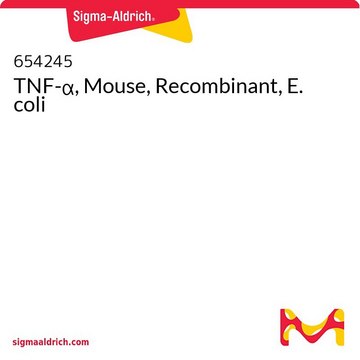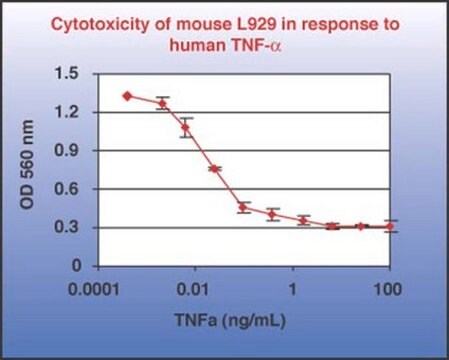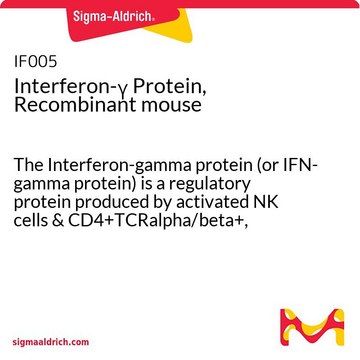T7539
Tumor Necrosis Factor-α from mouse
≥95%, recombinant, expressed in E. coli, powder, suitable for cell culture
Sinónimos:
mTNF-α, TNF-α
About This Item
Productos recomendados
product name
Tumor Necrosis Factor-α from mouse, TNF-α, recombinant, expressed in E. coli, powder, suitable for cell culture
biological source
mouse
Quality Level
recombinant
expressed in E. coli
assay
≥95%
form
powder
potency
0.01-0.5 ng/mL EC50
mol wt
17 kDa
packaging
pkg of 10 μg
pkg of 50 μg
storage condition
avoid repeated freeze/thaw cycles
technique(s)
cell culture | mammalian: suitable
impurities
≤1 EU/μg protein endotoxin
color
white
solubility
water: soluble
UniProt accession no.
storage temp.
−20°C
Gene Information
mouse ... Tnf(21926)
Application
- to activate MS1 endothelium cells
- to induce lipolysis in adipocytes
- to study its effect on liganded and unliganded glucocorticoid receptor (GR) in interleukin (IL)-6 and IL-8 gene regulation
Biochem/physiol Actions
Unit Definition
Physical form
signalword
Warning
hcodes
Hazard Classifications
Eye Irrit. 2 - Skin Irrit. 2
Storage Class
11 - Combustible Solids
wgk_germany
WGK 3
flash_point_f
Not applicable
flash_point_c
Not applicable
ppe
Eyeshields, Gloves, type N95 (US)
Certificados de análisis (COA)
Busque Certificados de análisis (COA) introduciendo el número de lote del producto. Los números de lote se encuentran en la etiqueta del producto después de las palabras «Lot» o «Batch»
¿Ya tiene este producto?
Encuentre la documentación para los productos que ha comprado recientemente en la Biblioteca de documentos.
Artículos
Lipid Induced Insulin Resistance
Nuestro equipo de científicos tiene experiencia en todas las áreas de investigación: Ciencias de la vida, Ciencia de los materiales, Síntesis química, Cromatografía, Analítica y muchas otras.
Póngase en contacto con el Servicio técnico








